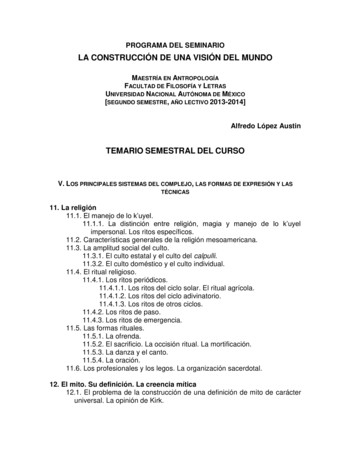QUALITY RISK MANAGEMENT (QRM) Just Another Regulation .
QUALITY RISK MANAGEMENT(QRM)The basic concepts of Quality Assurance,Good Manufacturing Practice, QualityControl and Quality Risk Management areinter-related.Just another regulation?GXPPROin Partnership withTorbay NHSInitiate Quality Risk ManagementRisk AssessmentRisk CommunicationRisk ControlRisk ReductionRisk AcceptanceOutput / Results of the QRM ProcessRisk ReviewReview Events4and1. Organise available information/assemble team InitiationRiskIdentification2. Define the risk question3. Choose tool4. Determine risk factors5. Define the scales for the risk factorsRisk Analysis6. Define the risk terms and/or develop matrix7. Determine the threshold for action8. Apply the toolRisk EvaluationRisk Reduction9. Define risk mitigating measuresOutput & Risk10. Document and ApproveAcceptanceplus Ongoing Risk ReviewRisk Review5Risk Management ToolsRisk AnalysisRisk EvaluationUnacceptableRisk Identification
ENVIRONMENTMANAGEMENT
First requirement of systemCovers where and when to useRecommends what tools to useStresses the need for cross function supportDetails requirements for report writingEmbeds in rest of Quality System Deviation reviewsCustomer complaintsChange requestsOOS investigationsProcess reviewsProcess efficiencies Identified one current area of concern Step 1: Preparation Step 3: Tool Selection Select project team (internal and external) Information gathering BrainstormingInformation gatheringRisk Ranking and filteringFMEACan use more than 1Step 2: Risk Question What tools are you going to use (don’t have to beformal) Issue with Low volume vialsAutomated system (high throughput)Decided to use as part of Initial training withConsultantUsed a 10-step formatCould be used for any process Define, Outcomes/ Scope and FactorsAgree before starting (difficult)Step 4: Risk Factors Usually Severity Probability / Likelihood of occurrence Detectability Step 5: Scales What scoring system are you going to use1-3/ 1-5/ High/ Medium / Low etc .
Step 6: Risk terms/ Matrix Which of the Risk factors are you going to useAre you going to use a matrix (3x3 or (3x3)x3 etc )Step 8: Perform Risk assessment Step 7: Action Threshold Step 9: Risk Identification Document outcomes/ CAPAAll team members to sign up to planCirculate summary to all critical partiesImplement actions (Change Control/ CAPA)Emphasis on team working Identify all Risks above pre-determined thresholdDiscuss ways of reducing risk and recordReduce risks to below Threshold (if possible)Can you live with Risk?Step 10: Document Brings together Prod/ QC/ QA/ maintenance etc.Draws on everyone's knowledgeBuilds trust and respectNo individual knows everythingSystematic What level of Risk are you happy to acceptAction limitsTriggers for Risk reduction strategiesMust agree before scoring (and use!!!!)Can be used for prospective (Process review) andRetrospective (Customer complaint) Input from ALL members of the teamGet more info if you need itBring different team members in (if required)Record all potential risks (even if discounted)Score every risk (don’t presume anything)Don’t change scoring system during Risk assessmentOnce actions implemented perform RA againHave Risks been eliminated/ ReduceComfortable with RisksHave actions added valueEnsure reviews on-goingIdentify any new risksIdentified Risks not previously thought ofShowed how many preconceived ideas heldShowed where the highest risk sources of errorwereLed to additional validation work onequipmentIdentified in-process checks to improveperformanceNo subsequent instances of problem (so far)
Customer complaintsMaintenance operationsProcess reviews (lean/ efficiency savings)Identifying Critical control points in a process Audit schedule review In-process monitoring Process reviews Highlight process efficienciesJustified approach (reduce historic processes)Combine with leanTarget resource to high risk areas (based on Riskassessment)Identification of CCPs (Critical Control points)For further details please feel free to contact me via email :mickgxppro@me.com or via telephone: 07724865209 Where should audit resource be targetedDon’t use fixed frequency schedulingCritical process done more frequently, others lessUsed for both Internal and Supplier auditsUse critical control points to reduce finished producttestingContinuous monitoring (water system)Big benefits if used correctly Enhanced team workingImproved complianceBetter understanding of processesGreater emphasis of risksTarget resourceEfficiency savings
2. Define the risk question 3. Choose tool 4. Determine risk factors 5. Define the scales for the risk factors 6. Define the risk terms and/or develop matrix 7. Determine the threshold for action 8. Apply the tool 9. Define risk mitigating measures 10. Document and Approve plus Ongoing Risk Review Initiation and
2. QRM CONSIDERATIONS FOR MEDICINES REGULATORY 7 AUTHORITIES 2.1 Assessment of dossiers 7 2.1.1 QRM system 8 2.1.2 Standard operating procedures 8 2.1.3 QRM deficiencies 8 2.2 Inspection activities 8
R Tools for Understanding Credit Risk Modelling QRM: Concepts, Techniques & Tools Alexander J. McNeil Heriot-Watt University, Edinburgh . 2 For obligors whose equity is traded on financial markets,pricescan be used to infer the market's view of the credit quality of the obligor. 2015 (QRM Tutorial) Alexander J. McNeil R/Finance Chicago 7 .
Volume 52 Number 7 July 2010 Next SFVARC Club Meeting Friday, July 16 at 7:30pm Northridge Hospital Penthouse 18300 Roscoe Blvd, Northridge, CA 91325 President’s QRM
1.9 Quality Control as part of GMP (covering the 8 requirements) 1.10 to 1.11 Product Quality Review (covering the 12 requirements) 1.12 Quality Risk Management QRM is a systematic process for the assessment, control, communication and review of risks to the quality of the medicinal product. It can be applied both proactively
81. Risk Identification, page 29 82. Risk Indicator*, page 30 83. Risk Management Ω, pages 30 84. Risk Management Alternatives Development, page 30 85. Risk Management Cycle, page 30 86. Risk Management Methodology Ω, page 30 87. Risk Management Plan, page 30 88. Risk Management Strategy, pages 31 89. Risk
of “risk” itself and even phrases such as quantitative risk assessment, quantitative risk evaluation, quantitative risk analysis, quantitative risk mitigation, also can be considered as subcategories for the phrase of “management”. Therefore, using a phrase of “QRM” alone can justify these scattered impressions.
Risk is the effect of uncertainty on objectives (e.g. the objectives of an event). Risk management Risk management is the process of identifying hazards and controlling risks. The risk management process involves four main steps: 1. risk assessment; 2. risk control and risk rating; 3. risk transfer; and 4. risk review. Risk assessment
Alfredo López Austin TEMARIO SEMESTRAL DEL CURSO V. LOS PRINCIPALES SISTEMAS DEL COMPLEJO, LAS FORMAS DE EXPRESIÓN Y LAS TÉCNICAS 11. La religión 11.1. El manejo de lo k’uyel. 11.1.1. La distinción entre religión, magia y manejo de lo k’uyel impersonal. Los ritos específicos. 11.2. Características generales de la religión mesoamericana. 11.3. La amplitud social del culto. 11.3.1 .























